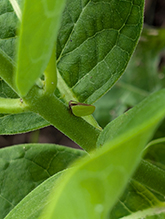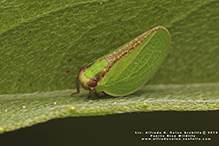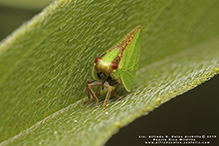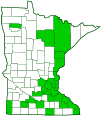two-striped planthopper
(Acanalonia bivittata)
Conservation • Description • Habitat • Ecology • Distribution • Taxonomy
|
|
||||||||||||||
Description |
Two-striped planthopper is a common planthopper that resembles a leaf in its environment. It occurs in the eastern half of the United States and in adjacent Canadian provinces. Adults are usually green, rarely pink, and 3⁄16″ to 5⁄16″ (5.2 to 8.4 mm). The body is flattened laterally. From above it appears wedge-shaped. The top of the head (vertex) is flat, horizontal, and rounded, not strongly projected forward between the eyes. When viewed from the side the face is straight, without a shelf-like step. The upper part of the face (frons), corresponding to the forehead, is mostly keeled. The antennae are attached on the sides of the head below the eyes. They are short, bristle-like, and three-segmented. The first segment is small and collar-like. There are two brown stripes, one on each lateral margin of the vertex and thorax, that extend along the inner margins of the forewings. The forewings are broadly oval and are longer than the body. They are prominently and irregularly net-veined over their entire surface. They are held almost vertical when at rest. The leading (costal) margin is also net-veined—there are no parallel veins along the margin. Two anal veins meet beyond the middle of the wing to form a Y vein. The hindwings are fully developed. On the hind leg, the fourth segment (tibia) has spines at the tip only, no lateral spines. The last part of the leg (tarsus), corresponding to a foot, has three segments. On the hind leg, the second tarsal segment is minute with a rounded tip and a spine at each side. |
Size |
Total length: 3⁄16″ to 5⁄16″ (5.2 to 8.4 mm) |
Similar Species |
Habitat |
Fields |
Ecology |
Season |
July through September |
Behavior |
|
Life Cycle |
|
Nymph Food |
|
Adult Food |
It feeds on a wide variety of plants |
Distribution |
||
|
Sources |
|
| 7/25/2024 | ||
Occurrence |
||
|
||
Taxonomy |
|
Order |
Hemiptera (True bugs, Hoppers, Aphids, and Allies) |
Suborder |
Auchenorrhyncha (true hoppers) |
Infraorder |
Fulgoromorpha (planthoppers) |
Superfamily |
Fulgoroidea |
Family |
Acanaloniidae |
Subfamily |
Acanaloniinae |
Tribe |
Acanaloniini |
Genus |
|
Subordinate Taxa |
|
|
|
Synonyms |
|
Acanalonia bivittata rubescens |
|
Common Names |
|
two-striped planthopper |
|
Glossary
Frons
The upper front part of an insect’s face, roughly corresponding to the forehead.
Tarsus
On insects, the last two to five subdivisions of the leg, attached to the tibia; the foot. On spiders, the last segment of the leg. Plural: tarsi.
Tibia
The fourth segment of an insect leg, after the femur and before the tarsus (foot). The fifth segment of a spider leg or palp. Plural: tibiae.
Vertex
The upper surface of an insect’s head.
Visitor Photos |
||
Share your photo of this insect. |
||
This button not working for you? |
||
Seirra Quinn |
||
 |
|
|
Alfredo Colon |
||
 |
||
 |
 |
|
MinnesotaSeasons.com Photos |
||
|
||
|
||

Slideshows |
|

Visitor Videos |
||
Share your video of this insect. |
||
This button not working for you? |
||
|
Other Videos |
||
Planthopper Nymph *Acanalonia Bivittata |
About
Jul 15, 2011 This is turning out to be the year for the leafhopper! I love leafhoppers/planthoppers:) I think this is a planthopper nymph |

Visitor Sightings |
||
Report a sighting of this insect. |
||
This button not working for you? |
||
| Seirra Quinn 6/20/2022 |
Location: Eden Valley, Minnesota |
 |
| Alfredo Colon 8/5/2022 |
Location: Albany, NY |
 |
| Alfredo Colon 8/7/2019 |
Location: Woodbury, Minnesota |
 |
MinnesotaSeasons.com Sightings |
||
|

Created: 9/28/2020 Last Updated: © MinnesotaSeasons.com. All rights reserved. |
